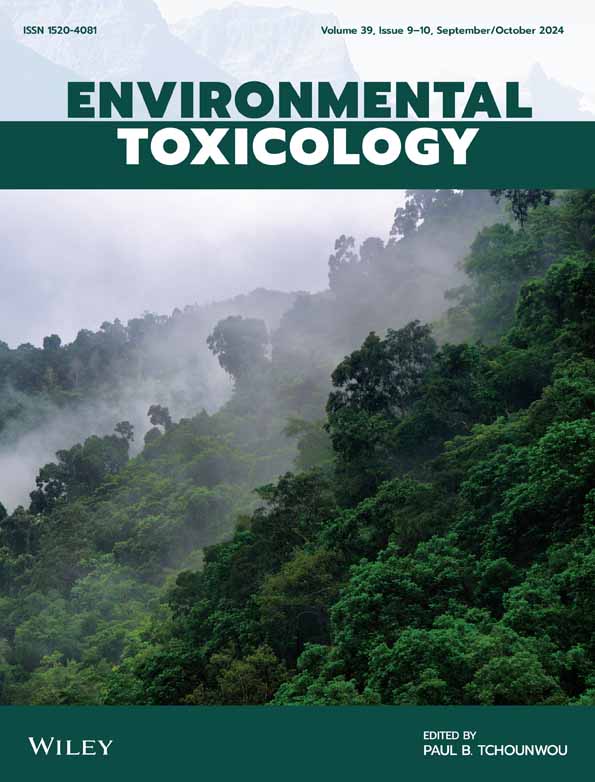Protective Effects of Liriodendrin Against Oxidative Stress and Ferroptosis in a Mouse Model of Lipopolysaccharide‐Induced Acute Respiratory Distress Syndrome
IF 3.2
3区 医学
Q2 ENVIRONMENTAL SCIENCES
引用次数: 0
Abstract
Liriodendrin, a bioactive lignan diglucoside derived from several medicinal plants, has been demonstrated to exhibit pharmacological activities, such as antioxidative and anti‐inflammatory activities. Up to now, no evidence has shown that acute respiratory distress syndrome (ARDS) is improved by liriodendrin. This study was conducted to investigate the protective effects of liriodendrin against oxidative stress and ferroptosis, key mechanisms underlying the pathogenesis of ARDS, in a mouse model of lipopolysaccharide (LPS)‐induced ARDS. To investigate the potential of liriodendrin to mitigate oxidative stress and inhibit ferroptosis, adult BALB/c male mice with LPS‐induced ARDS were treated with varying concentrations of liriodendrin. Mice received liriodendrin or dexamethasone before LPS administration. The effects of liriodendrin were evaluated by measuring changes in pulmonary histopathology, levels of lipid peroxidation, activities of antioxidative enzymes (superoxide dismutase, catalase, glutathione peroxidase), and expression of ferroptosis‐related proteins (heme oxygenase‐1, cystine/glutamate antiporter SLC7A11, glutathione peroxidase‐4). In addition, we measured the phosphorylation of nuclear factor erythroid 2‐related factor 2 (Nrf‐2), a critical regulator of cellular defense mechanisms against oxidative damage. The results indicated that liriodendrin substantially suppressed histopathological damage, reduced lipid peroxidation, and restored antioxidative enzyme activity in a dose‐dependent manner. Furthermore, this compound markedly upregulated the expression of ferroptosis‐related proteins and promoted the phosphorylation of Nrf‐2. Our findings suggest that liriodendrin protects against LPS‐induced ARDS by regulating oxidative stress and ferroptosis. The ability of liriodendrin to modulate both antioxidative responses and ferroptosis markers through Nrf‐2 phosphorylation highlights its potential as a therapeutic agent in the treatment of ARDS.鹅掌楸素对脂多糖诱导急性呼吸窘迫综合征小鼠模型氧化应激和铁中毒的保护作用
Liriodendrin是一种从几种药用植物中提取的生物活性木脂素二葡糖苷,已被证明具有抗氧化和抗炎等药理活性。到目前为止,还没有证据表明利碘树精对急性呼吸窘迫综合征(ARDS)有改善作用。本研究在脂多糖(LPS)诱导的ARDS小鼠模型中,探讨liriodendrin对氧化应激和铁下沉的保护作用,这是ARDS发病机制的关键机制。为了研究liriodendrin减轻氧化应激和抑制铁下沉的潜力,我们用不同浓度的liriodendrin治疗LPS诱导的ARDS成年BALB/c雄性小鼠。小鼠在LPS给药前分别给予利碘树精或地塞米松。通过测量肺组织病理学、脂质过氧化水平、抗氧化酶(超氧化物歧化酶、过氧化氢酶、谷胱甘肽过氧化物酶)活性和铁中毒相关蛋白(血红素加氧酶‐1、胱氨酸/谷氨酸反转运蛋白SLC7A11、谷胱甘肽过氧化物酶‐4)表达的变化来评估liriodendrin的作用。此外,我们测量了核因子红细胞2相关因子2 (Nrf - 2)的磷酸化,Nrf - 2是细胞防御氧化损伤机制的关键调节因子。结果表明,liriodendrin显著抑制组织病理损伤,减少脂质过氧化,恢复抗氧化酶活性,并呈剂量依赖性。此外,该化合物显著上调铁下垂相关蛋白的表达,并促进Nrf - 2的磷酸化。我们的研究结果表明,鹅掌楸素通过调节氧化应激和铁下垂来预防LPS诱导的ARDS。liriodendrin通过Nrf‐2磷酸化调节抗氧化反应和铁吊标志物的能力突出了其作为治疗ARDS的治疗药物的潜力。
本文章由计算机程序翻译,如有差异,请以英文原文为准。
求助全文
约1分钟内获得全文
求助全文
来源期刊

Environmental Toxicology
环境科学-毒理学
CiteScore
7.10
自引率
8.90%
发文量
261
审稿时长
4.5 months
期刊介绍:
The journal publishes in the areas of toxicity and toxicology of environmental pollutants in air, dust, sediment, soil and water, and natural toxins in the environment.Of particular interest are:
Toxic or biologically disruptive impacts of anthropogenic chemicals such as pharmaceuticals, industrial organics, agricultural chemicals, and by-products such as chlorinated compounds from water disinfection and waste incineration;
Natural toxins and their impacts;
Biotransformation and metabolism of toxigenic compounds, food chains for toxin accumulation or biodegradation;
Assays of toxicity, endocrine disruption, mutagenicity, carcinogenicity, ecosystem impact and health hazard;
Environmental and public health risk assessment, environmental guidelines, environmental policy for toxicants.
 求助内容:
求助内容: 应助结果提醒方式:
应助结果提醒方式:


